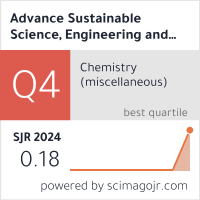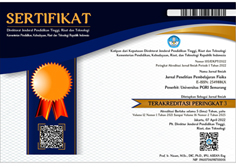Comparative Efficacy of Two Bamboo-Derived Activated Carbons for Hospital Wastewater Remediation
DOI:
https://doi.org/10.26877/asset.v7i3.1895Keywords:
bamboo charcoal, activated carbon, adsorptio, water quality, liquid medical waste.Abstract
Liquid medical waste containing pathogens and hazardous chemicals can pollute the environment and endanger human health. The increasing volume of waste during the COVID-19 pandemic adds urgency to find effective and sustainable treatment methods. However, environmentally friendly and efficient solutions are still limited. This study aims to explore the utilization of activated carbon from two local bamboo species, Gigantochloa apus (GA) and Bambusa vulgaris (BV) as alternative adsorbents in the treatment of liquid medical waste. Two-year-old bamboo was traditionally carbonized and activated using 0.3 M sodium chloride solution. The 50 mesh charcoal powder was tested using BET surface area analysis with QUADRASORB evo™ instrument, morphology using FESEM (FEI Quanta 650), and pollutant reduction efficiency through pH, TDS (HAIK EZ 9909), COD (HACH DBR 200 closed reflux method), and BOD (Winkler method with BOD 6 VELP system) measurements. The results showed that GA activated carbon exhibited a much higher adsorption capacity due to its larger BET surface area compared to BV. In addition, pH and Total Dissolved Solids (TDS) analysis showed that wastewater treated with GA activated carbon exhibited a greater reduction in TDS levels. The study also evaluated the reduction of Chemical Oxygen Demand (COD) and Biological Oxygen Demand (BOD), which confirmed that GA provided higher pollutant removal efficiency than BV. These findings underscore the potential of GA and BV as effective adsorbents for medical wastewater treatment, offering a sustainable solution to improve water quality and reduce environmental impacts associated with liquid medical waste.
References
[1] Padmanabhan KK, Barik D. Health hazards of medical waste and its disposal. Energy from toxic organic waste for heat and power generation, Elsevier; 2019, p. 99–118.
[2] Janik-Karpinska E, Brancaleoni R, Niemcewicz M, Wojtas W, Foco M, Podogrocki M, et al. Healthcare waste—a serious problem for global health. Healthcare, vol. 11, MDPI; 2023, p. 242.
[3] al-Sulbi K, Chaurasia PK, Attaallah A, Agrawal A, Pandey D, Verma VR, et al. A fuzzy TOPSIS-based approach for comprehensive evaluation of bio-medical waste management: advancing sustainability and decision-making. Sustainability 2023;15:12565.
[4] Tella TA, Festus B, Olaoluwa TD, Oladapo AS. Water and wastewater treatment in developed and developing countries: Present experience and future plans. Smart Nanomaterials for Environmental Applications, Elsevier; 2025, p. 351–85.
[5] Djarot IN, Pawignya H, Handayani T, Widyastuti N, Nuha N, Arianti FD, et al. Enhancing sustainability: microalgae cultivation for biogas enrichment and phycoremediation of palm oil mill effluent-a comprehensive review. Environmental Pollutants and Bioavailability 2024;36:2347314.
[6] Fan Q, Song C, Fu P. Advances in the improvement of the quality and efficiency of biomass-derived porous carbon: A comprehensive review on synthesis strategies and heteroatom doping effects. J Clean Prod 2024;452:142169.
[7] Zhang X, Wu H, He Z, Xie L, Chang Y, Jin Z, et al. Application of swirl intensification technology in thermochemical conversion of biomass to high-value bio-oil: A review. Sep Purif Technol 2025;354:128795.
[8] Saharimoghaddam N, Massoudinejad M, Ghaderpoori M. Removal of pollutants (COD, TSS, and NO3−) from textile effluent using Gambusia fish and Phragmites australis in constructed wetlands. Environ Geochem Health 2019;41:1433–44.
[9] Ferdous AR, Shah SS, Shaikh MN, Barai HR, Marwat MA, Oyama M, et al. Advancements in biomass‐derived activated carbon for sustainable hydrogen storage: a comprehensive review. Chemistry–An Asian Journal 2024;19:e202300780.
[10] Guo Z, Han X, Zhang C, He S, Liu K, Hu J, et al. Activation of biomass-derived porous carbon for supercapacitors: A review. Chinese Chemical Letters 2024;35:109007.
[11] Biswas S, Rahaman T, Gupta P, Mitra R, Dutta S, Kharlyngdoh E, et al. Cellulose and lignin profiling in seven, economically important bamboo species of India by anatomical, biochemical, FTIR spectroscopy and thermogravimetric analysis. Biomass Bioenergy 2022;158:106362.
[12] Zhao H, Liu H, Wei G, Zhang N, Qiao H, Gong Y, et al. A review on emergency disposal and management of medical waste during the COVID-19 pandemic in China. Science of the Total Environment 2022;810:152302.
[13] Zhi D, Yang D, Zheng Y, Yang Y, He Y, Luo L, et al. Current progress in the adsorption, transport and biodegradation of antibiotics in soil. J Environ Manage 2019;251:109598.
[14] Tobimatsu Y, Schuetz M. Lignin polymerization: how do plants manage the chemistry so well? Curr Opin Biotechnol 2019;56:75–81.
[15] Kumar A, Kumar J, Bhaskar T. Utilization of lignin: A sustainable and eco-friendly approach. Journal of the Energy Institute 2020;93:235–71.
[16] Roy R, Rahman MS, Amit TA, Jadhav B. Recent advances in lignin depolymerization techniques: A comparative overview of traditional and greener approaches. Biomass 2022;2:130–54.
[17] Zhu J, Wang H, Guo F, Salmén L, Yu Y. Cell wall polymer distribution in bamboo visualized with in situ imaging FTIR. Carbohydr Polym 2021;274:118653.
[18] Zhu J, Guo F, Ma C, Wang H, Wen J, Yu Y. The alkaline extraction efficiency of bamboo cell walls is related to their structural differences on both anatomical and molecular level. Ind Crops Prod 2022;178:114628.
[19] Kumar T, Ansari SA, Sawarkar R, Agashe A, Singh L, Nidheesh P V. Bamboo biochar: a multifunctional material for environmental sustainability. Biomass Convers Biorefin 2025:1–25.
[20] Yadav M, Dwibedi V, Sharma S, George N. Biogenic silica nanoparticles from agro-waste: Properties, mechanism of extraction and applications in environmental sustainability. J Environ Chem Eng 2022;10:108550.
[21] Gao Y, Yue Q, Gao B, Li A. Insight into activated carbon from different kinds of chemical activating agents: A review. Science of the Total Environment 2020;746:141094.
[22] Iwanow M, Gärtner T, Sieber V, König B. Activated carbon as catalyst support: precursors, preparation, modification and characterization. Beilstein Journal of Organic Chemistry 2020;16:1188–202.
[23] Ukanwa KS, Patchigolla K, Sakrabani R, Anthony E, Mandavgane S. A review of chemicals to produce activated carbon from agricultural waste biomass. Sustainability 2019;11:6204.
[24] Styks J, Wróbel M, Frączek J, Knapczyk A. Effect of compaction pressure and moisture content on quality parameters of perennial biomass pellets. Energies (Basel) 2020;13:1859.
[25] Chiu H-H, Young W-B. Characteristic study of bamboo fibers in preforming. J Compos Mater 2020;54:3871–82.
[26] Lou Z, Zheng Z, Yan N, Jiang X, Zhang X, Chen S, et al. Modification and application of bamboo-based materials: a review—Part II: application of bamboo-based materials. Forests 2023;14:2266.
[27] Feng Z, Li H, Ge L, Liu S, Corbi O, Liu Y, et al. Practicability and fundamental performance of alkali treated raw bamboo fiber reinforced high performance seawater sea sand concrete. Constr Build Mater 2024;446:137965.
[28] Sanchez PDC, Aspe MMT, Sindol KN. An overview on the production of bio-briquettes from agricultural wastes: methods, processes, and quality. Journal of Agricultural and Food Engineering 2022;1:2716–6236.
[29] Astika IM, Negara DNKP, Kencanawati C, Nindhia TGT, Hidajat F. Proximate and morphology properties of swat bamboo activated carbon carburized under different carbonization temperature. IOP Conf Ser Mater Sci Eng, vol. 539, IOP Publishing; 2019, p. 012010.
[30] Menya E, Jjagwe J, Kalibbala HM, Storz H, Olupot PW. Progress in deployment of biomass-based activated carbon in point-of-use filters for removal of emerging contaminants from water: a review. Chemical Engineering Research and Design 2023;192:412–40.
[31] Zhu K, Liu Q, Dang C, Li A, Zhang L. Valorization of hydrothermal carbonization products by anaerobic digestion: Inhibitor identification, biomethanization potential and process intensification. Bioresour Technol 2021;341:125752.
[32] Bernal MÁ, Boluda Botella N, Prats D. Removal of emerging pollutants in water treatment plants: adsorption of methyl and propylparaben onto powdered activated carbon 2019.
[33] Xiong J, Zhang S, Ke L, Wu Q, Zhang Q, Cui X, et al. Research progress on pyrolysis of nitrogen-containing biomass for fuels, materials, and chemicals production. Science of The Total Environment 2023;872:162214.
[34] Setyarini PH, Cendikia F, Sonief AA. Enhance the Quality of Medical Liquid Waste via Agitation Utilizing Hydrochloric Acid Activator in conjunction with Bamboo Activated Carbon. International Journal of Integrated Engineering 2024;16:144–52.
[35] Liu C, Zhang H-X. Modified-biochar adsorbents (MBAs) for heavy-metal ions adsorption: A critical review. J Environ Chem Eng 2022;10:107393.
[36] Zhang Y, Zhu C, Liu F, Yuan Y, Wu H, Li A. Effects of ionic strength on removal of toxic pollutants from aqueous media with multifarious adsorbents: A review. Science of the Total Environment 2019;646:265–79.
[37] Zhang Y, Liu W, Hu J, Lin J, Huang Y. Novel bamboo-derived composites for the efficient adsorption of a methylene blue pollutant. J Mater Sci 2024;59:18533–47.
[38] Ahmad A, Ali M, Al-Sehemi AG, Al-Ghamdi AA, Park J-W, Algarni H, et al. Carbon-integrated semiconductor photocatalysts for removal of volatile organic compounds in indoor environments. Chemical Engineering Journal 2023;452:139436.
[39] Lamaming J, Saalah S, Rajin M, Ismail NM, Yaser AZ. A review on bamboo as an adsorbent for removal of pollutants for wastewater treatment. International Journal of Chemical Engineering 2022;2022:7218759.
[40] Mersal ME, Kuok KK, Rahman MR, Chan CP, Bakri MK Bin, Chowdhury MDA, et al. Effect of activated carbon compaction on water filtration efficiency. Bioresources 2024;19:5300.
[41] Yang J, Fu L, Wu F, Chen X, Wu C, Wang Q. Recent developments in activated carbon catalysts based on pore size regulation in the application of catalytic ozonation. Catalysts 2022;12:1085.
[42] Spencer W, Senanayake G, Altarawneh M, Ibana D, Nikoloski AN. Review of the effects of coal properties and activation parameters on activated carbon production and quality. Miner Eng 2024;212:108712.
[43] Kumar N, Pandey A, Sharma YC. A review on sustainable mesoporous activated carbon as adsorbent for efficient removal of hazardous dyes from industrial wastewater. Journal of Water Process Engineering 2023;54:104054.
[44] Rubinsin NJ, Karim NA, Timmiati SN, Lim KL, Isahak WNRW, Pudukudy M. An overview of the enhanced biomass gasification for hydrogen production. Int J Hydrogen Energy 2024;49:1139–64.
[45] Zhang J, Yu S, Wang J, Zhao Z-P, Cai W. Advanced water treatment process by simultaneous coupling granular activated carbon (GAC) and powdered carbon with ultrafiltration: Role of GAC particle shape and powdered carbon type. Water Res 2023;231:119606.
[46] Nasir FN, Titah HS. The Use of GAC (Granular Activated Carbon) and Zeolite as an Adsorbent to Reduce The Concentration of Phosphate in Laundry Wastewater. Jurnal Syntax Transformation 2024;5:416–32.
[47] McQuillan R V, Stevens GW, Mumford KA. The electrochemical regeneration of granular activated carbons: A review. J Hazard Mater 2018;355:34–49.











